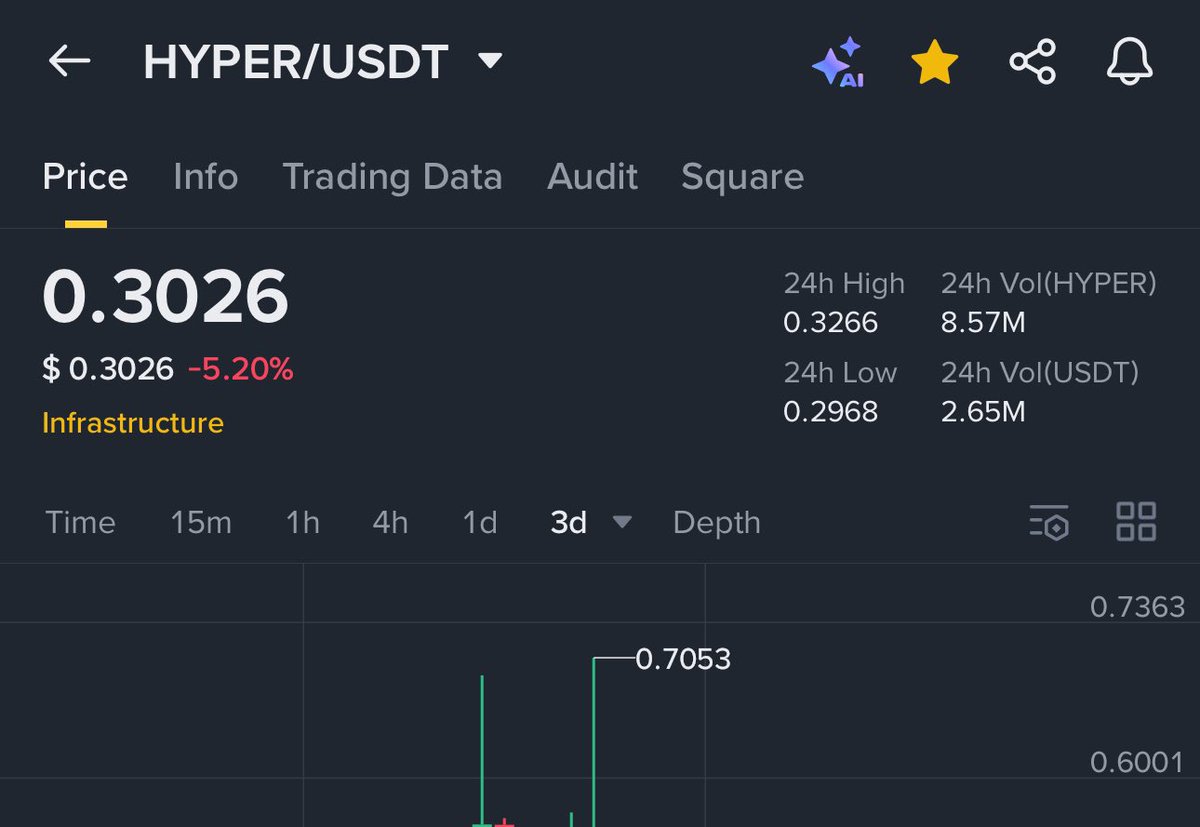Cena Tellor
w EUR

Informacje o Tellor

Zastrzeżenie
OKX nie udziela rekomendacji dotyczących inwestycji ani aktywów. Musisz dokładnie rozważyć, czy handel lub posiadanie aktywów cyfrowych jest dla Ciebie odpowiednie w świetle Twojej sytuacji finansowej. W przypadku pytań dotyczących konkretnej sytuacji skonsultuj się ze swoim doradcą prawnym, podatkowym lub specjalistą ds. inwestycji. Aby uzyskać więcej informacji, zapoznaj się z warunkami użytkowania i ostrzeżeniem o ryzyku. Korzystając z witryny internetowej strony trzeciej („TWP”), akceptujesz, że wszelkie korzystanie z TPW będzie podlegać warunkom TPW i będzie regulowane przez te warunki. O ile nie zostało to wyraźnie określone na piśmie, OKX i jego podmioty stowarzyszone („OKX”) nie są w żaden sposób powiązane z właścicielem lub operatorem TPW. Zgadzasz się, że OKX nie ponosi odpowiedzialności za jakiekolwiek straty, szkody i inne konsekwencje wynikające z korzystania z TPW. Pamiętaj, że korzystanie z TPW może spowodować utratę lub zmniejszenie Twoich aktywów. Produkt może nie być dostępny we wszystkich jurysdykcjach.
Wydajność ceny Tellor
Tellor na mediach społecznościowych

Przewodniki

Utwórz bezpłatne konto OKX.
Zasil swoje konto.
Wybierz swoją kryptowalutę.
Najczęściej zadawane pytania Tellor
Tellor to zdecentralizowana platforma Oracle zbudowana na blockchainie Ethereum, zaprojektowana w celu ułatwienia dostępu do dokładnych i wiarygodnych danych poza łańcuchem dla aplikacji blockchain. Wykorzystując sieć górników, Tellor zapewnia dostarczanie bezpiecznych i odpornych na manipulacje danych do inteligentnych kontraktów.
Tokeny TRB oferują kilka korzyści użytkownikom w sieci Tellor. Jako posiadacze TRB, osoby fizyczne mogą aktywnie uczestniczyć w zarządzaniu platformą, umożliwiając im proponowanie i głosowanie nad ważnymi decyzjami.
Dodatkowo, obstawianie tokenów TRB umożliwi użytkownikom przyczynienie się do bezpieczeństwa sieci i konsensusu, prowadząc do nagród za ich aktywne zaangażowanie. Co więcej, tokeny TRB stanowią bramę do uzyskiwania dostępu i subskrybowania wiarygodnych źródeł danych, zapewniając w ten sposób wiarygodność i dokładność zdecentralizowanych aplikacji i inteligentnych kontraktów.
Z łatwością kupuj tokeny TRB na platformie kryptowalutowej OKX. Dostępne pary handlowe w terminalu handlu spot OKX obejmująTRB/USDT. Możesz także zamienić swoje istniejące kryptowaluty, w tymBitcoin (BTC),Ethereum (ETH),Tether (USDT)orazMoneta USD (USDC), dla TRB bez opłat i bez poślizgu cenowego za pomocąFunkcja OKX Convert.
Pogłąb wiedzę o Tellor
Tellor (TRB) to unikalny projekt w dynamicznym świecie kryptowalut, skupiający się na zdecentralizowanych wyroczniach i godnej zaufania transmisji danych dla ekosystemów blockchain. Jego innowacyjne podejście i silna infrastruktura sprawiły, że Tellor stał się kluczowym graczem, zapewniając dokładne i odporne na manipulacje źródła danych dla zdecentralizowanych aplikacji (Dapps) i inteligentnych kontraktów.
Czym jest Tellor?
Tellor to zdecentralizowana platforma Oracle opracowana na blockchainie Ethereum. Oracles łączą dane w łańcuchu i poza nim, dostarczając zewnętrzne informacje do inteligentnych kontraktów. Głównym celem Tellor jest ułatwienie bezpiecznego dostępu do wysokiej jakości, pozbawionych zaufania danych dla DApps. Poprzez sieć niezależnych górników, Tellor zapewnia dokładność, niezawodność i odporność na manipulacje swoich danych.
Zespół Tellor
Projekt Tellor został założony przez Brendana Coburna i Nicka Fetta, którzy zidentyfikowali potrzebę zdecentralizowanego rozwiązania oracle, aby napędzać ekspansję ekosystemu blockchain. Dzięki zespołowi wykwalifikowanych programistów i pasjonatów blockchain, Tellor zyskał znaczne uznanie i stał się znaczącą postacią w domenie Oracle. Poświęcenie zespołu na rzecz przejrzystości, bezpieczeństwa i aktywnego zaangażowania społeczności było kluczowe dla osiągnięć projektu.
Jak działa Tellor?
Tellor wykorzystuje charakterystyczny mechanizm konsensusu znany jako Proof of Work Oracle (PoWo), który łączy w sobie cechy zarówno wydobywania Proof of Work, jak i zdecentralizowanych wyroczni. W ramach konsensusu PoWo górnicy rywalizują o rozwiązywanie zagadek obliczeniowych i przesyłanie punktów danych do inteligentnego kontraktu Tellor. Te punkty danych są następnie agregowane, a najbardziej precyzyjna wartość jest określana i udostępniana aplikacjom Dapps i inteligentnym kontraktom.
TRB: natywny token Tellor
TRB jest natywnym tokenem użytkowym ekosystemu Tellor, odgrywającym istotną rolę w zarządzaniu siecią, motywowaniu górników i uzyskiwaniu dostępu do źródeł danych. Posiadacze TRB mają prawo głosu w sprawie aktualizacji systemu, zmian parametrów i ulepszeń, zapewniając zdecentralizowany proces decyzyjny. Ponadto TRB jest wykorzystywany jako zabezpieczenie dla stakingu i uczestnictwa w mechanizmie konsensusu, co zwiększa ogólne bezpieczeństwo sieci.
Tellor tokenomia
Tellor tokenomics oferuje stałą podaż 2,4 miliona tokenów TRB, zaprojektowanych w celu zachęcenia do uczestnictwa w sieci i utrzymania zdrowego ekosystemu. Górnicy otrzymują nowo wybite tokeny TRB jako nagrody za dostarczanie dokładnych danych, podczas gdy posiadacze tokenów mogą stawiać swoje TRB, aby uczestniczyć w konsensusie i zdobywać dodatkowe nagrody. Niedobór TRB i jego użyteczność w ekosystemie przyczynia się do jego wartości.
Przypadki użycia tokenów Tellor
Tokeny TRB mają wiele zastosowań w ekosystemie Tellor. Działają jako narzędzie zarządzania, umożliwiając posiadaczom tokenów proponowanie i głosowanie nad krytycznymi decyzjami. TRB jest wykorzystywany jako zabezpieczenie do stakingu i uczestnictwa w procesie konsensusu, zwiększania bezpieczeństwa sieci i zdobywania nagród. Co więcej, tokeny te mogą być wykorzystywane do uzyskiwania dostępu i subskrybowania kanałów danych, umożliwiając aplikacjom DApps i inteligentnym kontraktom wykorzystywanie wysokiej jakości i wiarygodnych informacji.
Dystrybucja tokenów Tellor
Dystrybucja tokenów TRB przebiegała zgodnie z uczciwym podejściem do uruchomienia, zapewniając uczestnikom równe szanse na nabycie tokenów. Część tokenów została przydzielona wczesnym zwolennikom, doradcom i zespołowi założycielskiemu. Pozostałe tokeny były stopniowo uwalniane poprzez nagrody za wydobycie i wysiłki na rzecz rozwoju ekosystemu.
Przyszłość zdecentralizowanych wyroczni z Tellor
Tellor jest liderem w rewolucjonizowaniu zdecentralizowanych wyroczni, umożliwiając aplikacjom blockchain dostęp do wiarygodnych danych ze świata rzeczywistego. Dzięki zdecentralizowanemu rozwiązaniu Oracle, Tellor zwiększa wydajność i wiarygodność inteligentnych kontraktów, zapewniając odporny na manipulacje dostęp do danych dla zdecentralizowanych aplikacji. Dzięki zaangażowanemu zespołowi, innowacyjnej technologii i solidnemu ekosystemowi tokenów, Tellor ma szansę odegrać kluczową rolę w kształtowaniu przyszłości zdecentralizowanych finansów i napędzaniu powszechnej adopcji blockchain.
Ujawnienie ESG





